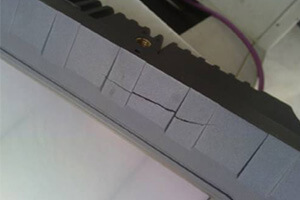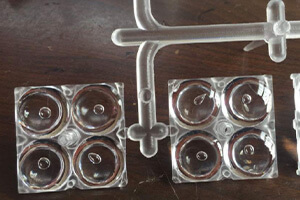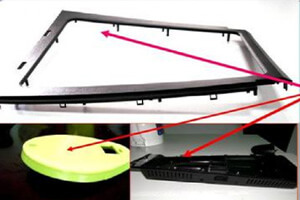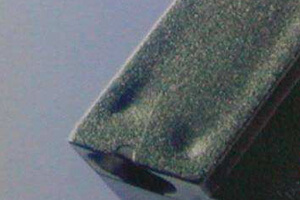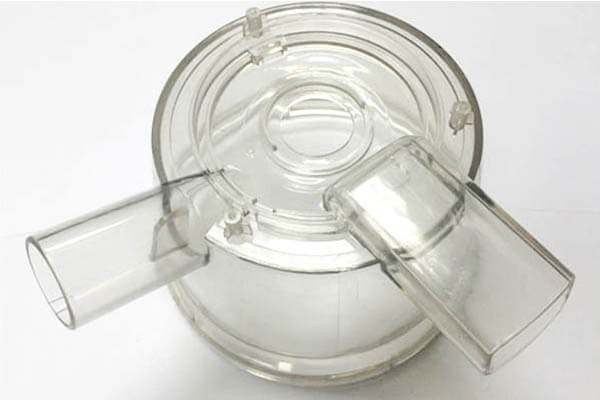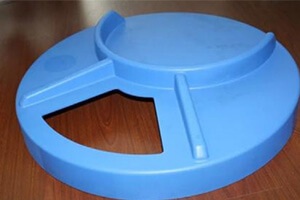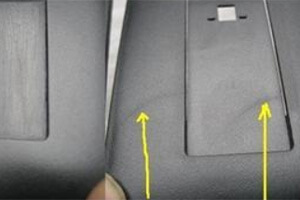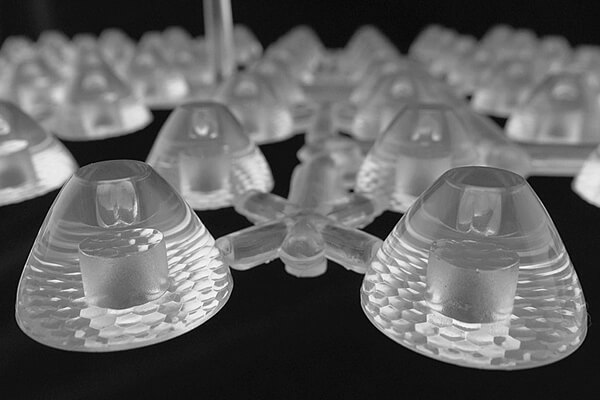Comprehensive Guide to 12 Injection Molding Defects and Their Solutions
Cracking of injection molded products – injection molding defects
Cracking of injection molded products includes filamentary cracks, microcracks, top whitening and cracking on the surface of the parts. They are caused by mold sticking of plastic parts and flow channel, and it is divided into demoulding cracking and application cracking according to the cracking time.
Reasons and solutions
Processing:
- 1. Excessive processing pressure, too fast speed, more filling materials, too long injection and pressure holding time will cause excessive internal stress and cracking.
- 2. Adjust the mold opening speed and pressure to prevent the rapid and forced drawing of parts from cracking caused by demoulding.
- 3. Properly increase the mold temperature to make the parts easy to demould, and properly reduce the material temperature to prevent decomposition.
- 4. Prevent cracking due to weld marks and plastic degradation resulting in lower mechanical strength.
- 5. Properly use the release agent, and pay attention to frequently eliminating the aerosol and other substances attached to the mold surface.
- 6. The residual stress of the workpiece can be eliminated by annealing heat treatment immediately after forming to reduce the generation of cracks.
Injection mold aspect:
- 1. Ejection must be balanced, such as the number and cross-sectional area of ejector pins must be sufficient, the demoulding slope must be sufficient, and the cavity surface must be smooth enough, so as to prevent cracking due to the concentration of ejection residual stress caused by an external force.
- 2. The structure of the workpiece should not be too thin, and the transition part should adopt a circular arc transition as much as possible to avoid stress concentration caused by sharp corners and chamfers.
- 3. Minimize the use of metal inserts to prevent the internal stress from increasing due to the difference in shrinkage between the insert and the workpiece.
- 4. Appropriate demoulding air intake channels should be provided for deep bottom parts to prevent the formation of vacuum negative pressure.
- 5. The sprue is enough to make the gate material demould before it solidifies, so it is easy to demould.
- 6. The joint between the sprue bushing and the nozzle should prevent the dragging of the cold hard material and make the part stick to the fixed mold.
Material aspects:
- 1. The content of recycled materials is too high, resulting in low strength of the parts.
- 2. Excessive humidity will cause some plastics to react chemically with water vapor, reduce the strength and cause ejection cracking.
- 3. The material itself is not suitable for the environment being processed or the quality is not good, and it will cause cracking if it is polluted.
Machine aspect:
The plasticizing capacity of the injection molding machine should be appropriate. If it is too small, the plasticizing capacity will not be fully mixed and will become brittle. If it is too large, it will degrade.
Product bubbles – injection molding defects
The air bubble (vacuum bubble) is very thin and belongs to the vacuum bubble. Generally speaking, if bubbles are found at the moment of mold opening, it is a gas interference problem. Vacuum bubbles are formed due to insufficient filling of the plastic or low pressure. Under the rapid cooling of the mold, the fuel at the corner of the cavity is pulled, resulting in volume loss.
Solution:
- 1. Increase the injection energy: pressure, speed, time and material volume, and increase the back pressure to make the mold full.
- 2. Increase the material temperature and flow smoothly. Lower the material temperature to reduce shrinkage, and increase the mold temperature appropriately, especially the local mold temperature where the vacuum bubble is formed.
- 3. Set the gate at the thick part of the workpiece, improve the flow conditions of the nozzle, runner and gate, and reduce the consumption of pressure.
- 4. Improve the exhaust condition of the mold.
Warping deformation of plastic products-injection molding defects
The occurrence of deformation, bending and twisting of injection molded products is mainly due to the fact that the shrinkage rate in the flow direction is larger than that in the vertical direction during plastic molding, which makes the parts warp due to different shrinkage rates in each direction. In addition, due to the large internal stress that inevitably remains inside the part during injection filling, warpage is caused. These are manifestations of deformation caused by high-stress orientation.
Therefore, fundamentally speaking, the mold design determines the warping tendency of the workpiece. It is very difficult to suppress this tendency by changing the molding conditions. The final solution to the problem must start with the mould design and improvement.
Reasons and solutions
Injection mold aspect:
- 1. The thickness and quality of the workpiece should be uniform.
- 2.The cooling system should be designed to make the temperature of each part of the mould cavity uniform, and the gating system should make the material flow symmetrical to avoid warping due to different flow directions and shrinkage rates, and appropriately thicken the runners and main flow of the difficult-to-form parts Road, try to eliminate the density difference, pressure difference, temperature difference in the cavity.
- 3. The transition area and corners of the thickness of the part should be smooth enough, and there must be good demoulding, such as increasing the demoulding margin, improving the polishing of the mold surface, and maintaining a balanced ejection system.
- 4.The exhaust should be good.
- 5. Increase the wall thickness of the part or increase the anti-warping direction, and use the rib to enhance the anti-warping ability of the part.
- 6.The strength of the material used in the mold is insufficient.
Plastics:
Crystalline plastics have more chances of warping deformation than amorphous plastics, and crystalline plastics can correct warping deformation by using the crystallization process in which the crystallinity decreases with the increase of cooling rate and the shrinkage rate becomes smaller.
Processing:
- 1. If the injection pressure is too high, the holding time is too long, the temperature of the melt is too low, and the speed is too fast, the internal stress will increase and warpage will occur.
- 2. The mold temperature is too high and the cooling time is too short, so the workpiece is overheated during demoulding and ejection deformation occurs.
- 3. Reduce the screw speed and back pressure to reduce the density while maintaining the minimum filling amount to limit the generation of internal stress.
- 4. If necessary, the parts that are easy to warp and deform can be softly shaped by the mold or removed from the mold after the rice is removed.
Plastic product color line – injection molding defect
The appearance of this kind of defect is mainly a problem that often occurs in plastic parts colored with masterbatch. Although masterbatch coloring is superior to dry powder coloring and dye paste coloring in terms of color stability, color purity and color migration, the distributability, that is, the degree of uniform mixing of color particles in diluted plastics, is relatively poor. Finished products naturally have regional color variations.
Main solution:
- 1. Increase the temperature of the feeding section, especially the temperature at the rear end of the feeding section, so that the temperature is close to or slightly higher than the temperature of the melting section, so that the masterbatch melts as soon as possible when it enters the melting section, promotes uniform mixing with dilution, and increases the chance of liquid mixing.
- 2. When the screw speed is constant, increasing the back pressure can increase the temperature and shearing effect of the molten material in the barrel.
- 3. Modify the mould, especially the gating system. If the gate is too wide, the turbulence effect will be poor when the molten material passes through, and the temperature rise will not be high, so it will be uneven, and the ribbon cavity should be narrowed.
Plastic product shrinkage depression-injection molding defect
During the injection molding process, product shrinkage and depression are relatively common phenomena.
Reasons and solutions
Machine aspect:
- 1. If the nozzle hole is too large, it will cause the molten material to flow back and shrink, and if it is too small, the resistance will be too large and the amount of material will not be enough to shrink.
- 2. Insufficient clamping force will cause the flash to shrink. Check whether there is any problem with the clamping system.
- 3. If the amount of plasticization is insufficient, a machine with a large amount of plasticization should be selected to check whether the screw and barrel are worn.
Injection mold aspect:
- 1. The part design should make the wall thickness uniform and ensure consistent shrinkage.
- 2. The cooling and heating system of the mold must ensure that the temperature of each part is consistent.
- 3. The gating system must be smooth and the resistance should not be too large. For example, the size of the main channel, runner, and gate must be appropriate, the finish must be sufficient, and the transition zone must have a circular arc transition.
- 4. For thin parts, the temperature should be increased to ensure smooth material flow, and for thick-walled parts, the mold temperature should be lowered.
- 5. The gate should be opened symmetrically, try to open it in the thick-walled part of the part, and the volume of the cold slug well should be increased
Plastic raw materials:
The shrinkage of crystalline plastics is worse than that of non-crystalline plastics. During processing, the amount of material should be increased appropriately, or an agent should be added to the plastics to speed up crystallization and reduce shrinkage depressions.
Injection molding processing:
- 1. The temperature of the barrel is too high and the volume changes greatly, especially the temperature of the forehearth. For plastics with poor fluidity, the temperature should be raised appropriately to ensure smooth flow.
- 2. The injection pressure, speed, back pressure are too low, and the injection time is too short, so that the material volume or density is insufficient and the shrinkage pressure, speed, and back pressure are too high, and the time is too long, resulting in flash and shrinkage.
- 3. If the amount of feed is too large, the injection pressure will be consumed, and if it is too small, the amount of feed will be insufficient.
- 4. For parts that do not require precision, after the injection is completed and the pressure is maintained, the outer layer is basically condensed and hardened, and the sandwich part is still soft and can be ejected. Release the mould early and let it cool slowly in the air or hot water. It can make the shrinkage sag gently and not so conspicuous without affecting the use.
Transparency defects of injection molded products
Melting spots, silver streaks, cracked polystyrene, and transparent parts of plexiglass, sometimes some gleaming filaments of silver streaks can be seen through the light. These crazes are also called flicker spots or cracks. This is due to the stress generated in the vertical direction of the tensile stress, and the difference in the rate of completion of the unoriented part of the polymer molecule is shown by the heavy flow orientation.
Solutions
- 1. Eliminate the interference of gas and other impurities, and fully dry the plastic.
- 2. Lower the material temperature, adjust the barrel temperature in sections, and increase the mold temperature appropriately.
- 3. Increase the injection pressure and reduce the injection speed.
- 4. Increase or decrease the pre-plastic back pressure, and reduce the screw speed.
- 5. Improve the flow channel and cavity exhaust condition.
- 6. Clean up possible blockages of nozzles, runners and gates.
- 7. Shorten the molding cycle, and annealing can be used to eliminate silver streaks after demoulding: for polystyrene, keep it at 78°C for 15 minutes, or at 50°C for 1 hour, and for polycarbonate, heat it above 160°C and keep it for several minutes.
Uneven color of injection molded products
The main reasons and solutions for the uneven color of injection molded products are as follows:
- 1. Poor diffusion of the colorant, which often causes patterns near the gate.
- 2. The thermal stability of plastics or colorants is poor. To stabilize the color tone of the parts, the production conditions must be strictly fixed, especially the material temperature, material quantity and production cycle.
- 3. For crystalline plastics, try to make the cooling speed of each part of part consistent. For parts with large differences in wall thickness, colorants can be used to mask the color difference. For parts with relatively uniform wall thickness, the material temperature and mold temperature should be fixed.
- 4. The shape of the part, the form of the gate, and the position have an impact on the filling of the plastic, which will cause color differences in some parts of the part, and it must be modified if necessary.
Gloss defects of injection molded products
Under normal circumstances, the gloss on the surface of injection molded parts is mainly determined by the type of plastic, the colorant and the smoothness of the mold surface. However, it is often caused by some other reasons to cause defects such as surface color and gloss defects, surface dark color, etc. of the product.
Reasons and solutions
- 1. The finish of the mould is poor, the surface of the cavity has rust, etc., and the exhaust of the mold is poor.
- 2. The gating system of the mold is defective, the cold slug well should be increased, the runners, polished main runners, runners and gates should be increased.
- 3. The material temperature and mold temperature are low, if necessary, local heating of the gate can be used.
- 4. The injection molding processing pressure is too low, the speed is too slow, the injection time is insufficient, and the back pressure is insufficient, resulting in poor compactness and darkening of the surface.
- 5. The plastic should be fully plasticized, but the degradation of the material must be prevented, the heating must be stable, and the cooling must be sufficient, especially for thick-walled ones.
- 6. To prevent cold material from entering the workpiece, use a self-locking spring or lower the temperature of the nozzle if necessary.
- 7. Too much recycled material is used, the quality of plastic or colorant is poor, mixed with water vapor or other impurities, and the quality of lubricant used is poor.
- 8. The clamping force should be sufficient.
Silver marks on plastic products – injection molding defects
Silver streaks of injection molded products, including surface air bubbles and internal pores. The main cause of defects is the interference of gases (mainly water vapor, decomposition gas, solvent gas, and air).
Reasons and solutions
Machine aspect:
- 1. The barrel and screw are worn or there is a material flow dead angle in the rubber head and the rubber ring, which will be decomposed by long-term heating.
- 2. The heating system is out of control, causing the temperature to be too high and decomposed. Check whether there is any problem with the heating elements such as thermocouples and heating coils. Improper screw design can cause cracks or easily bring in air.
Injection mold aspect:
- 1. Poor exhaust.
- 2. The friction resistance of runners, injection gates, and cavities in the steel mold is large, causing local
- overheating and decomposition.
- 3. Unbalanced distribution of gates and cavities, and unreasonable cooling system will cause unbalanced heating and local overheating or blocked air passages.
- 4. The cooling channel leaks water into the cavity.
Plastic raw materials:
- 1. The humidity of the plastic is high, and the proportion of recycled materials is too much or contains harmful scraps (the scraps are easy to decompose). The plastics should be fully dried and the scraps should be eliminated.
- 2. To absorb moisture from the atmosphere or from the colorant, the colorant should also be dried, and it is best to install a dryer on the machine.
- 3. The amount of lubricants, stabilizers, etc. added to the plastic is too much or mixed unevenly, or the plastic itself contains volatile solvents. Decomposition can also occur when mixed plastics are exposed to extreme heat.
- 4. The plastic is polluted and mixed with other plastics.
Processing:
- 1. When the temperature, pressure, speed, back pressure, and melt motor speed are too high to cause decomposition, or the pressure and speed are too low, the injection time, pressure holding is insufficient, and the back pressure is too low, the density is insufficient due to failure to obtain high pressure Silver streaks appear due to inability to melt the gas, appropriate temperature, pressure, speed and time should be set and multi-stage injection speed should be used
- 2. Low back pressure and fast speed can easily cause air to enter the barrel and enter the injection mold with the molten material. When the cycle is too long, the molten material is heated in the barrel for too long and decomposes.
- 3. Insufficient material quantity, too large feeding cushion, too low material temperature or too low mold temperature will affect the flow of material and molding pressure, and promote the formation of air bubbles.
Injection Weld Line – Injection Defect
When the molten plastic meets the insert hole, the area where the flow rate is inconsistent, and the area where the filling material flow is interrupted in the cavity and merges in multiple strands, a linear weld seam is produced because it cannot be completely fused. In addition, when the gate injection mold filling occurs, a weld seam will also be generated, and the strength and other properties of the weld seam are very poor.
Reasons and solutions
Processing:
- 1. The injection pressure and speed are too low, the barrel temperature and mold temperature are too low, resulting in premature cooling of the molten material entering the mold and the occurrence of weld seams.
- 2. When the injection pressure and speed are too high, jets will appear and weld seams will appear.
- 3. The rotation speed should be increased, and the back pressure should be increased to reduce the viscosity of the plastic and increase the density.
- 4. The plastic should be dry well, and the recycled materials should be used sparingly. If the amount of release agent is too much or the quality is not good, there will be weld seams.
- 5. Reduce the clamping force and facilitate exhaust.
Plastic injection mold aspect:
- 1. If there are too many gates in the same cavity, the gates should be reduced or set symmetrically, or set as close to the weld joint as possible.
- 2. The exhaust at the welding seam is poor, and an exhaust system should be installed.
- 3. The sprue is too large, the size of the gating system is improper, and the gate is opened to prevent the melt from flowing around the hole of the insert as much as possible, or use less inserts as much as possible.
- 4. If the wall thickness changes too much, or the wall thickness is too thin, the wall thickness of the workpiece should be uniform.
- 5. If necessary, a fusion well should be opened at the welding seam to separate the welding seam from the workpiece.
Plastic raw materials:
- 1. For plastics with poor fluidity or heat sensitivity, lubricants and stabilizers should be added appropriately.
- 2. The plastic contains a lot of impurities, so replace it with good quality plastic if necessary.
Injection molded product chatter marks – injection defects
Rigid plastic parts such as PS form dense corrugations on the surface near the gate with the gate as the center, sometimes called vibration lines. The reason is that when the viscosity of the melt is too high and the steel mold is filled in stagnation, the material at the front end will condense and shrink as soon as it touches the surface of the cavity, and the later melt will expand and the cold material that has shrunk will continue to advance. The continuous alternation makes the material flow form the surface vibration pattern in the progress.
Solutions
- 1. Increase the barrel temperature, especially the nozzle temperature, and the mold temperature should also be increased.
- 2. Increase the injection pressure and speed to quickly fill the mold cavity.
- 3. Improve the size of runners and gates to prevent excessive resistance.
- 4. The exhaust of the injection mold should be good, and a large enough cold well should be set.
- 5. The parts should not be designed too thin.
Swelling and bubbling of injection molded products
Some plastic parts swell or bubble quickly on the back of the metal insert or in particularly thick areas after molding and demolding. This is because the plastic that has not completely cooled and hardened releases gas and expands under the action of internal pressure penalties.
Solution:
- 1. effective cooling. Reduce the injection mold temperature, prolong the steel mold opening time, and reduce the drying and processing temperature of the material.
- 2. Reduce the filling speed, reduce the forming cycle, and reduce the flow resistance.
- 3. Increase the holding pressure and time.
- 4. Improve the situation that the wall surface of the workpiece is too thick or the thickness changes greatly.
This article provides a comprehensive guide to identifying and resolving common injection molding defects. It provides an overview of the injection molding process and discusses key factors that contribute to defects such as warpage, sink marks, and voids. The article also provides practical tips and strategies for addressing each type of defect. Also, effective communication between plastic injection molding manufacturers and their customers is critical to ensure products meet the required specifications and quality standards. We also recommend that plastic product manufacturers prioritize regular maintenance of injection moulds to ensure consistent quality.
About Sungplastic
Sungplastic is a plastic product manufacturer with rich experience in injection molding. According to the different product development requirements, we flexibly adjust the manufacturing process to achieve high quality, high efficiency and more economical.
We offer a variety of manufacturing services: Rapid Prototyping, Tool Making, Injection Molding, Product Design and Development, CNC Machining and Metal Stamping. You can choose from a variety of plastics, silicone rubber, or metal for your product. Regardless of mass production or small batch customization, Sungplastic has always been committed to providing assured, efficient and more economical one-stop processing services for your projects.
Contact us for a free quote and project review.
Get a free quote and design analysis today.
We’ll reply to you within 6 working hours.
We respect your privacy.
+86 139 2927 4777 (WhatsApp, Wechat)

